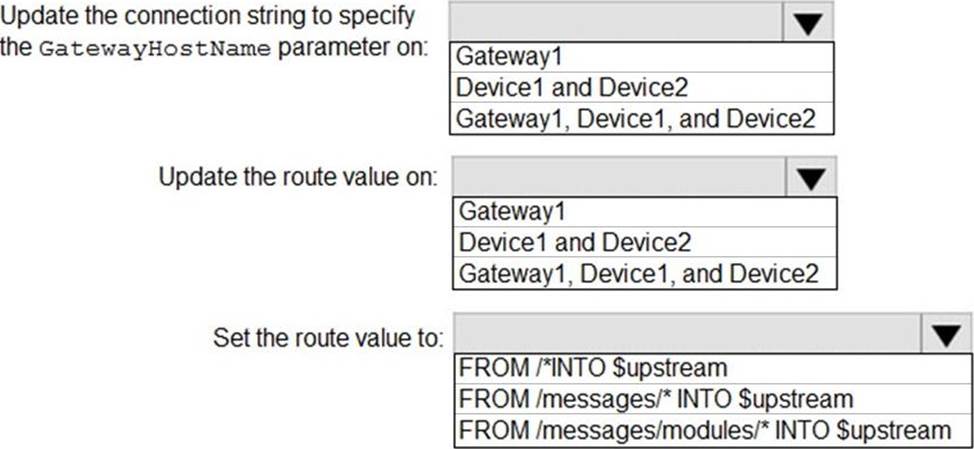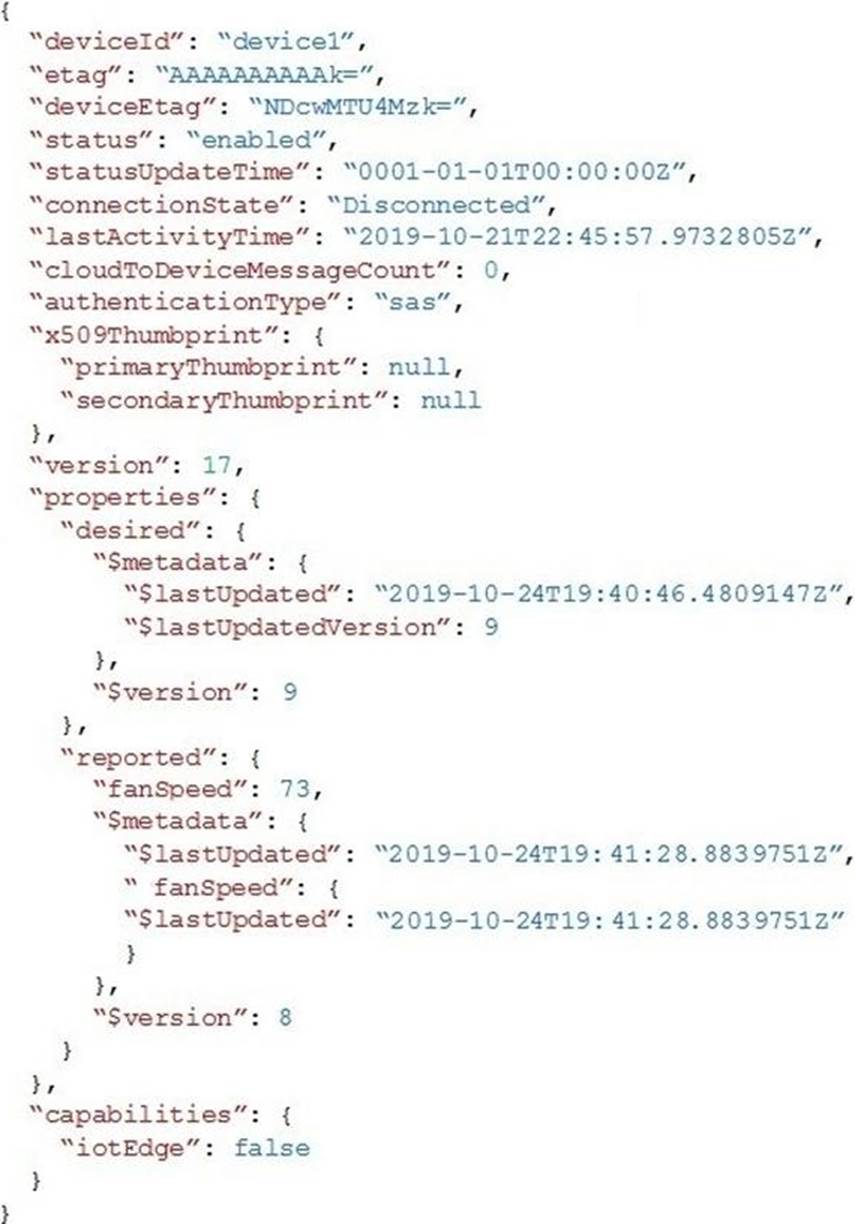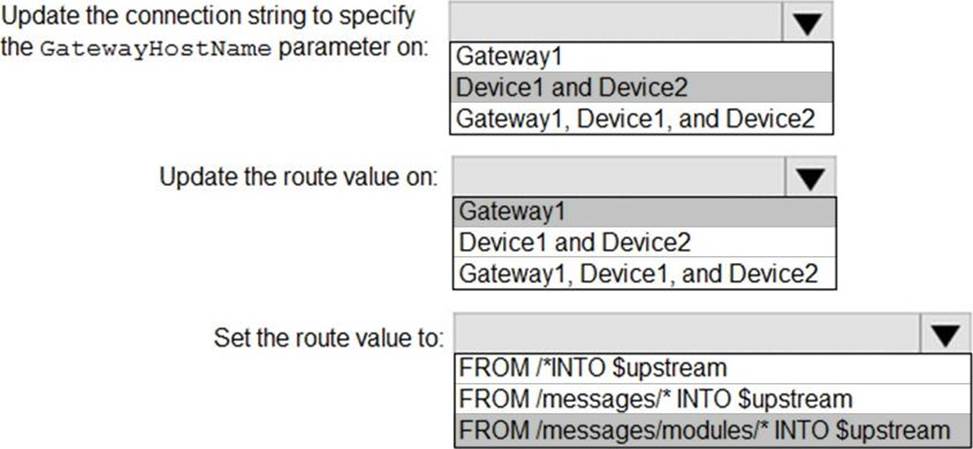Microsoft AZ-220 Microsoft Azure IoT Developer Online Training
Microsoft AZ-220 Online Training
The questions for AZ-220 were last updated at Dec 25,2025.
- Exam Code: AZ-220
- Exam Name: Microsoft Azure IoT Developer
- Certification Provider: Microsoft
- Latest update: Dec 25,2025
HOTSPOT
You have an Azure subscription that contains an Azure IoT hub and two IoT devices named Device1 and Device2.
You plan to deploy an Azure IoT Edge gateway device named Gateway1.
You need to ensure that all device-to-cloud messages and twin change notifications from Device1 and Device2 to the IoT hub are routed by using Gateway1.
What tasks should you perform to configure the devices? To answer, select the appropriate options in the answer area. NOTE: Each correct selection is worth one point.

You are developing an Azure IoT solution for a shipping company. The company’s ships will have sensors used for predictive maintenance. Some sensor devices will be MQTT-capable, and others will use Modbus.
Each ship has an internet connection that is available only when the ship is docked.
You create an Azure IoT hub.
You need to implement an IoT solution that uses Azure IoT Edge.
What should you do?
- A . Configure an loT Edge gateway. Deploy an loT Edge Modbus module. From the Azure portal, create loT devices and add connection strings to the devices.
- B . Add the MQTT devices to the loT hub and configure an loT Edge gateway. From the loT Edge gateway device, assign the MQTT devices as child devices of the gateway. Use the File upload feature of loT Hub when internet connectivity is available.
- C . Add the MQTT devices to the loT hub. configure an loT Edge gateway, and set Enable connection to loT Hub to Disable. From the loT Edge gateway device, assign the MQTT devices as child devices of the gateway. Deploy the loT Edge Modbus module.
- D . Add the MQTT devices to the loT hub and configure an loT Edge gateway. From the loT Edge gateway device, assign the MQTT devices as child devices of the gateway. Deploy an loT Edge Modbus module.
You have an Azure IoT solution that includes an Azure IoT Hub named Hub1 and an Azure IoT Edge device named Edge1. Edge1 connects to Hub1.
You need to deploy a temperature module to Edge1.
What should you do?
- A . From the Azure portal, navigate to Hub1 and select IoT Edge. Select Edge1, and then select Manage Child Devices. From a Bash prompt, run the following command:
az iot edge set-modules -device-id Edge1 -hub-name Hub1 -content C:
deploymentMan1.json - B . Create an IoT Edge deployment manifest that specifies the temperature module and the route to
$upstream. From a Bush prompt, run the following command:
az iot hub monitor-events-device-id Edge1 -hub-name Hub1 - C . From the Azure portal, navigate to Hub1 and select IoT Edge. Select Edge1, select Device Twin, and then set the deployment manifest as a desired property. From a Bash prompt, run the following command
az iot hub monitor-events-device-id Edge1 -hub-name Hub1 - D . Create an IoT Edge deployment manifest that specifies the temperature module and the route to
$upstream. From a Bush prompt, run the following command:
az iot edge set-modules -device-id Edge1 -hub-name Hub1 -content C:
deploymentMan1.json
You have an Azure IoT Edge module named SampleModule that runs on a device named Device1.
You make changes to the code of SampleModule by using Microsoft Visual Studio Code.
You need to push the code to the container registry and then deploy the module to Device1.
Which two actions should you perform from Visual Studio Code? Each correct answer presents part of the solution. NOTE: Each correct selection is worth one point.
- A . Build and push the SampleModule code to the registry.
- B . Create a deployment for a single device.
- C . Generate a deployment manifest.
- D . Build an loT Edge solution.
- E . Generate a shared access signature (SAS) token for Device 1.
You have an existing Azure IoT hub.
You need to connect physical IoT devices to the IoT hub.
You are connecting the devices through a firewall that allows only port 443 and port 80.
Which three communication protocols can you use? Each correct answer presents a
complete solution. NOTE: Each correct selection is worth one point.
- A . MQTT over WebSocket
- B . AMQP
- C . AMQP over WebSocket
- D . MQTT
- E . HTTPS
You have an Azure IoT hub that uses a Device Provisioning Service instance to automate the deployment of Azure IoT Edge devices.
The IoT Edge devices have a Trusted Platform Module (TPM) 2.0 chip.
From the Azure portal, you plan to add an individual enrollment to the Device Provisioning Service that will use the TPM of the IoT Edge devices as the attestation mechanism.
Which detail should you obtain before you can create the enrollment.
- A . the scope ID and the Device Provisioning Service endpoint
- B . the primary key of the Device Provisioning Service shared access policy and the global device endpoint
- C . the X.509 device certificate and the certificate chain
- D . the endorsement key and the registration ID
Note: This question is part of a series of questions that present the same scenario. Each question in the series contains a unique solution that might meet the stated goals. Some question sets might have more than one correct solution, while others might not have a correct solution.
After you answer a question in this section, you will NOT be able to return to it. As a result, these questions will not appear in the review screen.
You have an Azure Stream Analytics job that receives input from an Azure IoT hub and sends the outputs to Azure Blob storage. The job has compatibility level 1.1 and six streaming units.
You have the following query for the job.

You plan to increase the streaming unit count to 12.
You need to optimize the job to take advantage of the additional streaming units and increase the throughput.
Solution: You change the query to the following.

Does this meet the goal?
- A . Yes
- B . No
HOTSPOT
You have the following device twin for the IoT device.

For each of the following statements, select Yes if the statement is true. Otherwise, select No. NOTE: Each correct selection is worth one point.

You have 10 devices that connect to an Azure loT hub. Each device has a unique public IP address. The devices are not provisioned through DPS.
You discover an anomaly in messages from two devices.
You need to stop all messages from both devices without affecting the other devices.
Solution: You create a custom endpoint for the loT hub and configure a message routing query to redirect events from suspicious devices.
Does this meet the goal?
- A . Yes
- B . No
You have an Azure IoT solution that contains an Azure IoT hub.
You need to ensure that the IoT hub configuration is compliant with the Health Insurance Portability and Accountability Act (HIPAA) audit logging requirements.
What should you use?
- A . Azure Advisor recommendations
- B . an Azure Policy definition
- C . Azure Monitor alerts
- D . an Azure Sentinel workspace
Latest AZ-220 Dumps Valid Version with 88 Q&As
Latest And Valid Q&A | Instant Download | Once Fail, Full Refund



